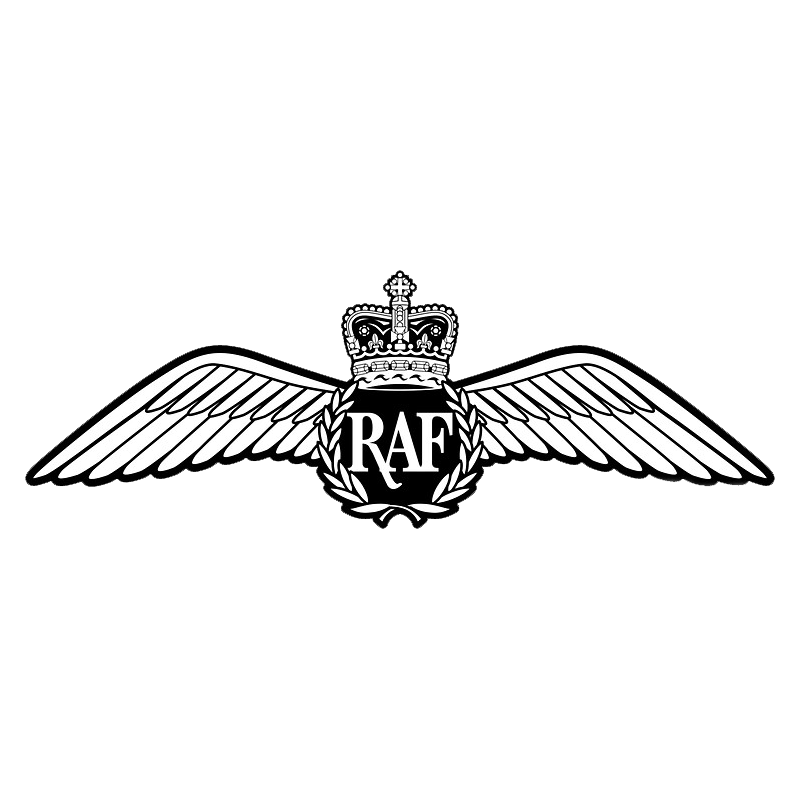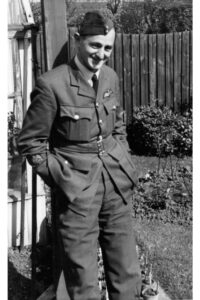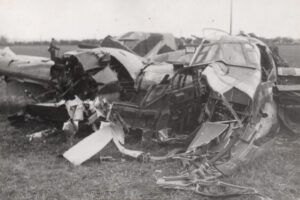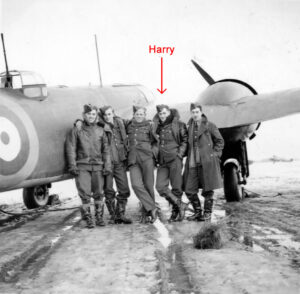WW2 up to D-Day
It was February 1941 and I had just got my “Wings” after 20 months of RAF training to be a pilot.
On the 17 th February, I moved to my first operational flights with 604 squadron based at Middle Wallop. Here I flew Blenheim Night Fighters. After losing too many of our tussles we soon discovered that the Blenheim was simply too slow to engage with the German fighter aircraft, including Messerschmitt 109, Messerschmitt 110, Heinkel 111 and Dornier.
We were then given Beaufighters which were faster and a fair match for the Germans. My base moved to 263 squadron, Filton, where we mainly flew Whirlwinds as day fighters.
We used what was known as the “1 Up” format. Spotters on the ground, other pilots and limited radar would alert our squadron to the presence of one or more German fighter planes within our area. Immediately, 1 of our squadron would “Up” and fly to a location where the German fighter was expected to be. Our planes had very limited radar, but we were told to use that to finally locate the plane that we were seeking. We were then instructed to position ourselves and our flight path so that we were flying in the same direction as the German fighter and underneath and behind it. We were instructed to then slowly rise so that the German pilot could not see us, and we could attack the German fighter from below and behind without any warning of our presence. That was great in theory, however, in reality things rarely went that way. Due to the German fighter changing directions, the poor quality of our radar, the inaccurate locations given to us by spotters and the constant movement of clouds we usually met the German fighter with both of us spotting each other at the same time and it instantly turned into a simple dogfight with nobody having an initial advantage. We always had a couple of planes at the head of the runway with a pilot onboard and engines ready to start so that we could take off as soon as we received a notification. We simply took it in turns to be the next one on the runway. The worst mental time for myself was laying in my bunk or sitting in the mess when I was third or fourth in line to take off. That wait could be anything from a few minutes to a few hours. Once we were sat in our plane, we were checking controls, reading weather forecasts, talking to our ground crew, etc. and our adrenaline started to run, taking the fear out of our bodies. As soon as we were instructed to take-off, there was no time to have thoughts about anything other than what we were actually doing.
After 7 months of successful operations as a fighter pilot I was transferred to 521 squadron as I was a trained and experienced Blenheim pilot which they needed. Here I was engaged in Special Operations for Coastal Command where I carried out Meteorological Reconnaissance. In order for the Army, Navy & RAF to decide what operations to carry out within the next 24/48 hours they needed to know the weather forecast. In those days, the only way to find out what the weather was doing somewhere was to go and look. Most days, and/or nights, we flew across southern England and up-and- down the English Channel and formed accurate reports as to cloud formations, visibility, temperatures, windspeeds and directions. When one of the services was hoping to carry out an operation, we had to go to that area a few hours before the operation was scheduled to arrive and form accurate reports for that area. This had two major drawbacks. Firstly, we had to fly over some of the most protected German areas as that is where most of special operations were aimed. Secondly, we had to fly in all weathers even when the majority of planes would be grounded. These two drawbacks made life exciting.
We were instructed to hide whenever possible and never engage with German aircraft unless they attacked us. This was due to the importance of the weather reports that we were bringing back to the RAF. We hid using clouds, mountains and low altitude over the sea. We still did engage with some German fighters, but we managed to fight them off. The Blenheim that we used had forward facing guns and 4 fully rotating guns in a turret just behind the cockpit. This meant that, once attacked, if we flew in irregular patterns, we had more chance of hitting the German fighters then they did of hitting us. Thank heaven I had a brilliant crew with an awesome turret gunner.
A few times we were flying back to England in the winter and our engines iced up and stopped working. Usually only 1 engine failed allowing us to limp back to England, and if required, land in a farmer’s field. On one occasion however we lost 1 engine as we left the French coast and managed to limp back towards our airfield but as we were aiming to land our 2nd engine cut out and we lost height rapidly so that we just caught our rear wheel on a tree or something and that flipped our Blenheim nose down and we crashed. Ironically it was that crash that showed my crew and I the importance of what we did. None of my crew died, we had broken bones and deep cuts, but we all lived to fight again. Just after we crashed, it went quiet, and we could hear vehicles approaching. I was helping my navigator to free his foot from the wreckage when a voice shouted “Navigator … Report”. I looked out and saw the chap on a motorcycle who collected the weather reports dismount and run towards us. My navigator gave me the weather report and I leant down out of the cockpit and gave it to the chap who grabbed it, turned, ran back to his bike, joined his 2 colleagues on their bikes and they all sped off without another single word. Seconds later the ambulances, fire engines and rescue team arrived and carefully took us away (and they all had caring words). We then realised just how critical those reports were for the armed services to make plans.
On August 3rd, 1941, just after I had started with Special Op’s, we were coming back over the English Channel, at very low altitude, when we saw a dinghy and a plane floating nearby. Against instructions, my crew agreed that I should double back and see what was there. We found an RAF Wellington Bomber slowly sinking and not far away 4 coloured chaps in a small dinghy. They appeared to have no oars or other aids and were therefore unable to find their own way home. I radioed the 16 Group Controller at central command and gave him the Bomber code and the description of the men. They confirmed the flight was genuine within a few minutes and we gave them a very approximate position. My navigator told me that if we climbed to cloud level he should be able to see far enough to fix their position on a map. My crew agreed instantly, and we climbed as fast as we could. Everyone was staring out of windows and hoping we didn’t encounter a German fighter. The navigator saw the French coast in the distance and instantly knew where we were, so he radioed Group Controller and I dived back down to see level. We circled them and gave them a thumbs up through the cockpit window and they all waved their arms in thanks. We were forced to leave them in another 15 minutes as we were short on fuel but as we left, we saw a small high-speed boat on the way to them. The next day the Group Controller phoned the officer commanding my MET Flight and left the following message: “11:04 4/8/41 Air Commodore Croke, Director of Air Sea Rescue, is very pleased with yesterday’s rescue work and wishes his congratulations to be conveyed to all concerned”. My Squadron Leader personally gave my crew and I the message and shook our hands. A few days later he took me aside and told me that I had risked serious charges by getting involved and not bringing the report back asap. He then shook my hand again and said, “but I would have expected no less” and winked.
After a few months, I became involved in special services for the Army and Navy. To give us a break from constantly being in a front line squadron we were sent on short missions to aid the navy, and later the army, by helping train their personnel. We towed targets for their gunners, carried out fake attacks on ships and land bases and aided in radar usage. This was an interesting task as the navy used live shells on the targets that we towed, on a very, very, very long rope. Later we even helped the Home Guard by fake attacks on areas near the towns and villages that they guarded.
As time progressed, different destinations required different approaches and as a result, I flew many types of aircraft, and that in itself was a breath of fresh air. This included Spitfires, Hurricanes, Beaufighters, Defiants and Swordfish amongst others, I think my favourite fighter was the Hurricane, it wasn’t quite as fast as a Spitfire, but it was reliable when you abused it and a lot easier to land in strong winds. My favourite plane with a crew was, by far, the Blenheim.
In March 1944 I was promoted to “Pilot Officer” and sent to Squadron 84 as part of the Invasion Team leading to D-Day. My experience to date was not that of a normal fighter pilot as I had spent a lot of time hiding in clouds, flying at low-altitudes and flying in an unconventional manner for the MET squadron and other tasks. Someone in power noticed this, promoted me, and posted me to the Invasion Team to “SPiT” on the VIP personnel from all 3 services along with “boffins” involved in planning.
Please see how I “SPiT” for the rest of the war in the section entitled “D-Day”.





